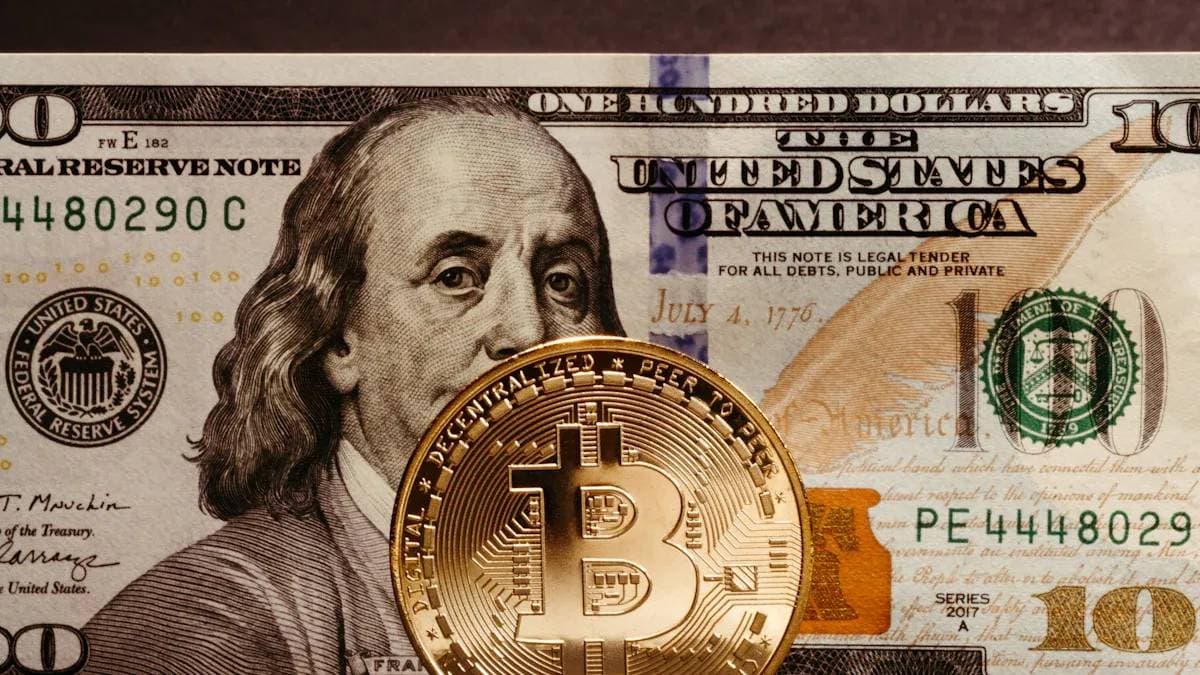- EasyCard
- Trade
- Help
- Announcement
- Academy
- SWIFT Code
- Iban Number
- Referral
- Customer Service
- Blog
- Creator
Are IBAN and routing number the same? Analyzing the core differences in international remittances.

Image Source: unsplash
Have you ever been confused about IBAN and routing numbers? Remember, they are two completely different codes and must never be mixed up. Understanding the differences between them is the first step to successful remittances.
You can think of IBAN as the “ID card” for international bank accounts, while a routing number is the “address code” for US bank institutions.
Key Points
- IBAN is the “ID card” for international bank accounts, mainly used for international remittances, especially widely in Europe.
- Routing number is the “address code” for US bank institutions, used only for financial transactions within the United States.
- IBAN and routing numbers are two different codes and cannot be mixed; mixing them will cause remittance failure.
- Before remitting, be sure to confirm the required information with the recipient to avoid loss of money and time.
- Banks in mainland China do not use IBAN; to remit to China, provide the SWIFT/BIC code and bank card number.
What is IBAN? Designed for International Remittances

Image Source: unsplash
IBAN (International Bank Account Number) is an international standard account number designed for cross-border transactions. Its main goal is to reduce transfer delays or failures caused by manual input errors.
Definition and Standard Structure
The design of IBAN follows the 13616 standard published by the International Organization for Standardization (ISO), aiming to promote automated processing of financial data. You can imagine it as a “super number” containing all information about the country, bank, and personal account.
A standard IBAN consists of the following parts:
- Two-digit country code: For example, DE for Germany, FR for France.
- Two-digit check digits: Used to verify the accuracy of the entire number and prevent input errors.
- Basic Bank Account Number (BBAN): Includes the bank code and your personal account number, with length and format varying by country.
IBAN lengths differ by country, but the structure is uniform. Here are two examples, and you can clearly see their composition:
| Country | Length | IBAN Example |
|---|---|---|
| Germany (DE) | 22 digits | DE75512108001245126199 |
| France (FR) | 27 digits | FR7630006000011234567890189 |
Main Uses and Applicable Regions
When you need to remit money overseas, especially in Europe, the recipient’s bank will almost certainly require you to provide an IBAN. It is key information for international wire transfers and electronic transfers.
Currently, over 80 countries and regions worldwide have adopted this system. Its scope is very broad, mainly including:
- Single Euro Payments Area (SEPA) countries: For example, Germany, France, Italy, Spain, etc.; transfers between these countries must use IBAN.
- Other European countries: Such as Switzerland, Norway, and the United Kingdom.
- Some countries outside Europe: For example, Brazil, Saudi Arabia, and the United Arab Emirates.
For international remittances, you usually need to provide both the recipient’s IBAN and the bank’s SWIFT/BIC code to ensure funds arrive accurately and quickly.
What is a Routing Number? Focused on US Domestic Transactions

Image Source: pexels
Unlike IBAN designed for international remittances, the routing number is the exclusive “address code” of the US financial system. If you have a bank account in the US or need to remit to a US account, understanding it is crucial.
Definition and Nine-Digit Encoding
The routing number, also known as ABA Routing Transit Number (ABA RTN), is a nine-digit code introduced by the American Bankers Association (ABA) in 1910. Initially, it was created to facilitate the processing of paper checks, helping banks quickly identify the paying institution. You can think of it as a unique identifier for every bank in the US.
This nine-digit code is not randomly combined; it contains precise geographic and bank information.
For example, the first four digits of the routing number are directly linked to a specific region and processing center of the Federal Reserve Bank. This system is maintained by the Fed, ensuring efficient and accurate payment processing.
Main Uses and Identification Function
The core function of the routing number is to identify the specific bank or credit union where your account is located. For financial transactions within the US, you almost always need to use it in conjunction with your personal account number (Account Number).
Its uses are very broad, covering all aspects of your daily financial activities:
- Setting up direct deposit for salary
- Conducting ACH electronic transfers (for example, paying bills or transferring between friends)
- Processing domestic wire transfers
- Linking third-party payment apps like PayPal to your bank account
- Ordering new personal or business checks
It is worth noting that the same bank may provide different routing numbers for different types of transactions. For example, the ACH routing number for electronic transfers and the routing number for domestic wire transfers may be different. Therefore, before conducting a specific transaction, it is best to confirm with your bank which number to use to avoid unnecessary delays.
Core Differences at a Glance
Now that you have learned about IBAN and routing numbers separately, let’s compare them directly and consolidate your understanding through specific scenarios. This way, you can be confident the next time you remit money.
Function and Scope Comparison
To make the differences clearer, the table below summarizes their core distinctions. You can save it as a quick reference guide.
| Feature | IBAN (International Bank Account Number) | Routing Number |
|---|---|---|
| Geographic Scope | Internationally universal, covering over 80 countries and regions including Europe and the Middle East. | Limited to use within the United States. |
| Identification Object | Precisely identifies a specific bank account, including country, bank, and personal account information. | Only identifies a bank institution, cannot locate a specific account. |
| Format Standard | Mix of letters and numbers, variable length, up to 34 digits. | Fixed 9 pure digits. |
| Main Uses | International remittances, especially transfers within the Single Euro Payments Area (SEPA). | US domestic electronic transfers (ACH), direct deposits, and domestic wire transfers. |
Remittance Scenario-Based Answers
Theoretical knowledge ultimately needs to be applied in practice. Let’s see how you should choose and use these numbers in real remittance scenarios.
Scenario One: Remitting from Mainland China to Germany
You need to remit from a bank in Hong Kong to a friend in Germany. At this time, you must provide the recipient’s IBAN to the bank. This number ensures funds cross borders and accurately enter your friend’s specific account in Germany. At the same time, the bank usually requires you to provide the recipient bank’s SWIFT/BIC code.
Scenario Two: Transferring Within the United States
You live in the US and need to set up direct deposit of your salary into your bank account. Your employer will ask you to provide the bank’s routing number and your personal account number. These two numbers together form the complete path for fund flow within the US.
Scenario Three:Remitting from the UK to the US
Your family remits from the UK to your account in the US. Why does the bank ask for both the SWIFT/BIC code and the routing number? This is because they play different roles:
- SWIFT/BIC code is like an international postal code, guiding funds from the UK bank to the corresponding bank in the US.
- Routing number is like a detailed domestic address, taking over within the US financial system to ensure funds are accurately allocated from this US bank to the specific branch where you opened the account.
Through these three scenarios, you can see that choosing the correct number depends entirely on the starting and ending points of the funds.
The Cost of Filling in the Wrong Number
You may think filling in a wrong digit is just a small mistake, but in the financial world, this small mistake can trigger a chain reaction. Understanding these potential costs will make you more cautious before every remittance.
Root Causes of Transaction Failure
When you submit a remittance, the bank’s automated system immediately starts working. It does not send the money directly but first conducts strict verification. One study shows that nearly one-third of payment failures are due to incorrect account numbers.
The bank system detects errors in the following ways:
- Structure Validation: The system checks whether the length and format of the IBAN or routing number meet the standard. For example, a routing number must be 9 digits.
- Check Digit Calculation: IBAN includes two special check digits. The system uses an algorithm called “MOD-97” to perform mathematical operations on the entire number. If the calculation result does not match, it proves there is an input error in the number.
- Database Matching: The system checks whether the routing number exists in its financial institution database.
If your information fails any step of verification, the transaction will be immediately rejected. You may receive an error code like “R04: Invalid Account Number” or “INVALID TRN”, and the remittance process stops here.
Potential Economic and Time Losses
Transaction failure is not just about re-operating; it directly leads to your economic and time losses.
Financial Losses 💸 Even if the remittance fails, the fees you have already paid may not be refunded. These losses include:
- Bankfees: Banks usually charge a fee for processing international wire transfers (for example, $45), and this money is likely non-refundable.
- Intermediary bank fees: Funds may be deducted additional fees by other handling banks on the way back.
- Exchange rate losses: If funds are exchanged into another currency in a failed transaction, you may receive less money upon refund due to exchange rate fluctuations.
These seemingly scattered fees accumulate into a huge global problem. Statistics show that in 2020 alone, failed electronic payments caused up to $118.5 billion in losses worldwide.
In addition to money, time costs are equally high. A failed remittance means you need to contact the recipient again, verify information, and restart the entire process, which may lead to overdue bills or delayed business cooperation. In rare cases, repeatedly submitting incorrect information may even trigger compliance risks, leading to fines or account restrictions.
Now you clearly understand that IBAN and routing numbers originate from completely different design concepts and financial systems, and they are two independent systems that must never be interchanged. To avoid confusion, remember the following core points.
Key Memory Points: For remittances to Europe and other IBAN regions, prepare the IBAN; for transfers within the US or from abroad to the US, the routing number is key (usually used with the SWIFT/BIC code).
The safest method before any remittance operation is to directly confirm the exact required information with the recipient. This helps you avoid errors from the source and ensure funds arrive safely and on time.
FAQ
To help you quickly resolve specific questions, we have compiled several of the most common ones.
Are IBAN and SWIFT Code the Same Thing?
They are completely different. You can understand it this way:
The SWIFT/BIC code is the international address of the bank, while IBAN is the unique house number of your personal account. Together, they ensure funds are accurately delivered.
Do Bank Accounts in Mainland China Have IBAN?
No. Banks in mainland China do not use the IBAN system. For remittances from abroad to mainland China, you usually need to provide the recipient bank’s SWIFT/BIC code and the recipient’s bank card number or passbook account number.
Can I Find the Routing Number on My Bank Card?
Usually not. The routing number is not printed on your debit or credit card. You can find it in the following places:
- Bottom left corner of personal checks
- Log in to online banking or mobile banking App to query
- Contact your bank directly to obtain
What Happens If I Fill in a Routing Number When Remitting to Europe?
Your remittance will almost certainly fail immediately. European bank systems cannot recognize US routing numbers. This will cause the transaction to be rejected, you may also need to bear the bank’s fees, and waste valuable time.
*This article is provided for general information purposes and does not constitute legal, tax or other professional advice from BiyaPay or its subsidiaries and its affiliates, and it is not intended as a substitute for obtaining advice from a financial advisor or any other professional.
We make no representations, warranties or warranties, express or implied, as to the accuracy, completeness or timeliness of the contents of this publication.




Contact Us
Company and Team
BiyaPay Products
Customer Services
BIYA GLOBAL LLC is a licensed entity registered with the U.S. Securities and Exchange Commission (SEC No.: 802-127417); a certified member of the Financial Industry Regulatory Authority (FINRA) (Central Registration Depository CRD No.: 325027); regulated by the Financial Industry Regulatory Authority (FINRA) and the U.S. Securities and Exchange Commission (SEC).
BIYA GLOBAL LLC is registered with the Financial Crimes Enforcement Network (FinCEN), an agency under the U.S. Department of the Treasury, as a Money Services Business (MSB), with registration number 31000218637349, and regulated by the Financial Crimes Enforcement Network (FinCEN).
BIYA GLOBAL LIMITED is a registered Financial Service Provider (FSP) in New Zealand, with registration number FSP1007221, and is also a registered member of the Financial Services Complaints Limited (FSCL), an independent dispute resolution scheme in New Zealand.




















